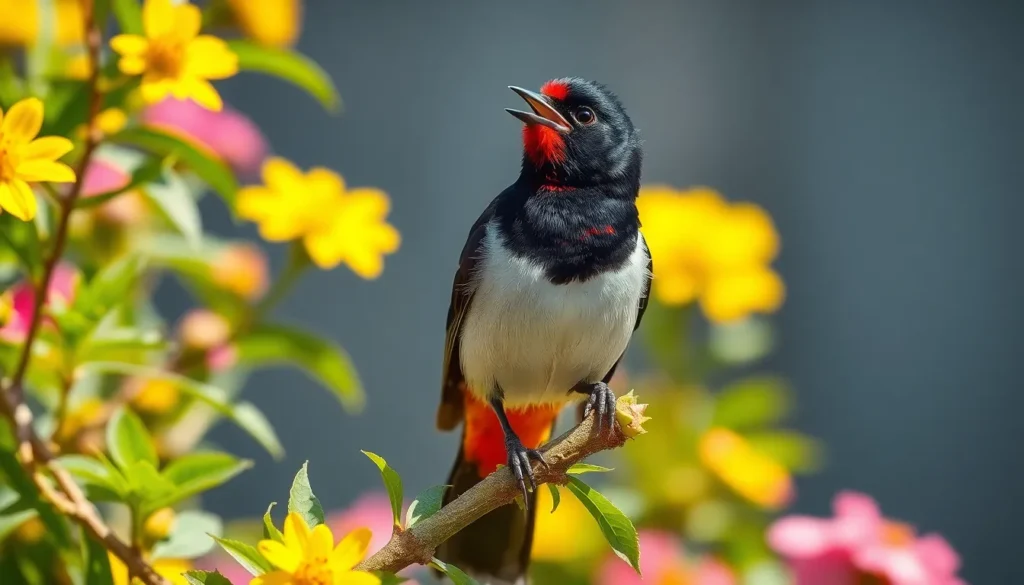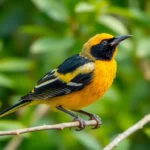We’ve all heard the melodious songs echoing through gardens and parks, but many of us don’t realize we’re listening to one of nature’s most accomplished vocalists – the bulbul bird. These charismatic songbirds have captivated humans for centuries with their impressive vocal range and distinctive appearance, making them beloved companions in both wild habitats and urban environments.
Found across Africa, Asia, and the Middle East, bulbuls represent a diverse family of over 150 species that’ve mastered the art of adaptation. From the vibrant Red-vented Bulbul to the striking Black-headed Bulbul, these birds showcase remarkable variety in their plumage patterns and behavioral traits.
What makes bulbuls truly fascinating isn’t just their beautiful songs – it’s their intelligence, social nature, and incredible ability to thrive alongside human populations. Whether you’re a seasoned birdwatcher or simply curious about the feathered friends in your neighborhood, understanding these remarkable birds will transform how you experience the natural industry around you.
What Is a Bulbul Bird?
Bulbuls represent a diverse family of songbirds belonging to the Pycnonotidae family that captivates bird enthusiasts worldwide. These medium-sized passerines typically measure 6 to 11 inches in length and possess distinctive features that make them easily recognizable in their natural habitats.
Most bulbul species display vibrant plumage ranging from olive-green and yellow to striking black and white patterns. Their pointed bills adapt perfectly for feeding on fruits, insects, and nectar while their sturdy legs enable agile movement through dense vegetation. Many species showcase prominent crest feathers that they raise during territorial displays or courtship rituals.
Bulbuls inhabit diverse ecosystems including tropical forests, woodlands, gardens, and urban parks across Africa, Asia, and the Middle East. Common species like the Red-whiskered Bulbul and Yellow-vented Bulbul thrive in both wild and cultivated environments. Their adaptability allows them to flourish near human settlements where they often become familiar garden visitors.
These intelligent birds demonstrate complex social behaviors including cooperative breeding in some species. Family groups frequently forage together while maintaining constant vocal communication through their repertoire of calls and songs. Their melodious vocalizations serve multiple purposes from territory establishment to mate attraction and danger alerts.
Bulbuls play crucial ecological roles as seed dispersers and pest controllers in their native ranges. They consume various fruits and berries while helping plants reproduce through seed distribution. Also, they control insect populations by feeding on caterpillars, beetles, and other garden pests that damage crops and ornamental plants.
Physical Characteristics of Bulbul Birds
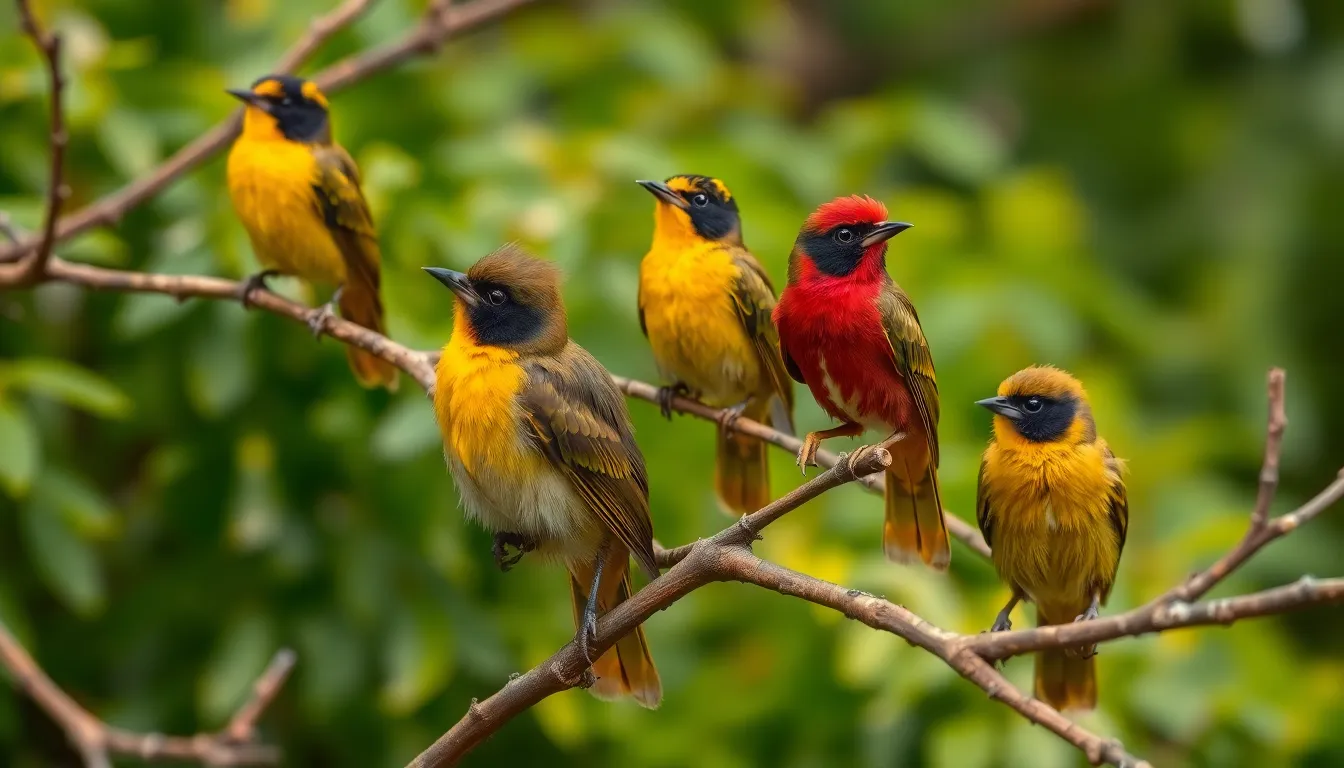
Bulbul birds display remarkable physical diversity across their 150+ species, with each adapting unique traits for their exact environments. These songbirds showcase a fascinating range of sizes, builds, and colorations that make them easily recognizable to birdwatchers worldwide.
Size and Build
Bulbuls exhibit consistent proportions across most species, measuring between 6 to 11 inches in total length. Their compact bodies feature sturdy legs that provide excellent grip on branches and allow confident movement through dense vegetation. Most species weigh between 0.5 to 2.5 ounces, making them medium-sized songbirds within the Pycnonotidae family.
The birds possess pointed bills designed for their varied diet of fruits, insects, and nectar. Their wings display moderate length with rounded tips, enabling agile flight through forest canopies and urban landscapes. Tail feathers contribute significantly to their overall length, often measuring 2 to 4 inches and helping with balance during feeding and perching.
Distinctive Features and Coloration
Bulbul plumage varies dramatically between species, ranging from subtle olive-green and brown tones to vibrant yellows, reds, and striking black-and-white patterns. The Red-whiskered Bulbul displays distinctive red patches behind its eyes and under its tail, while the Yellow-vented Bulbul features bright yellow undertail coverts that contrast with its darker upperparts.
Many species showcase crested head feathers that can be raised or lowered depending on mood and social situations. Their eyes typically appear dark brown or black, surrounded by colored eye-rings in certain species like the White-eared Bulbul. Throat patches often display contrasting colors, with some species featuring white, yellow, or red markings that serve as identification markers.
Sexual dimorphism remains minimal in most bulbul species, though males occasionally display slightly brighter coloration or more pronounced crests during breeding season. Juvenile birds typically exhibit duller plumage than adults, gradually developing their full adult coloration over several months.
Different Species of Bulbul Birds
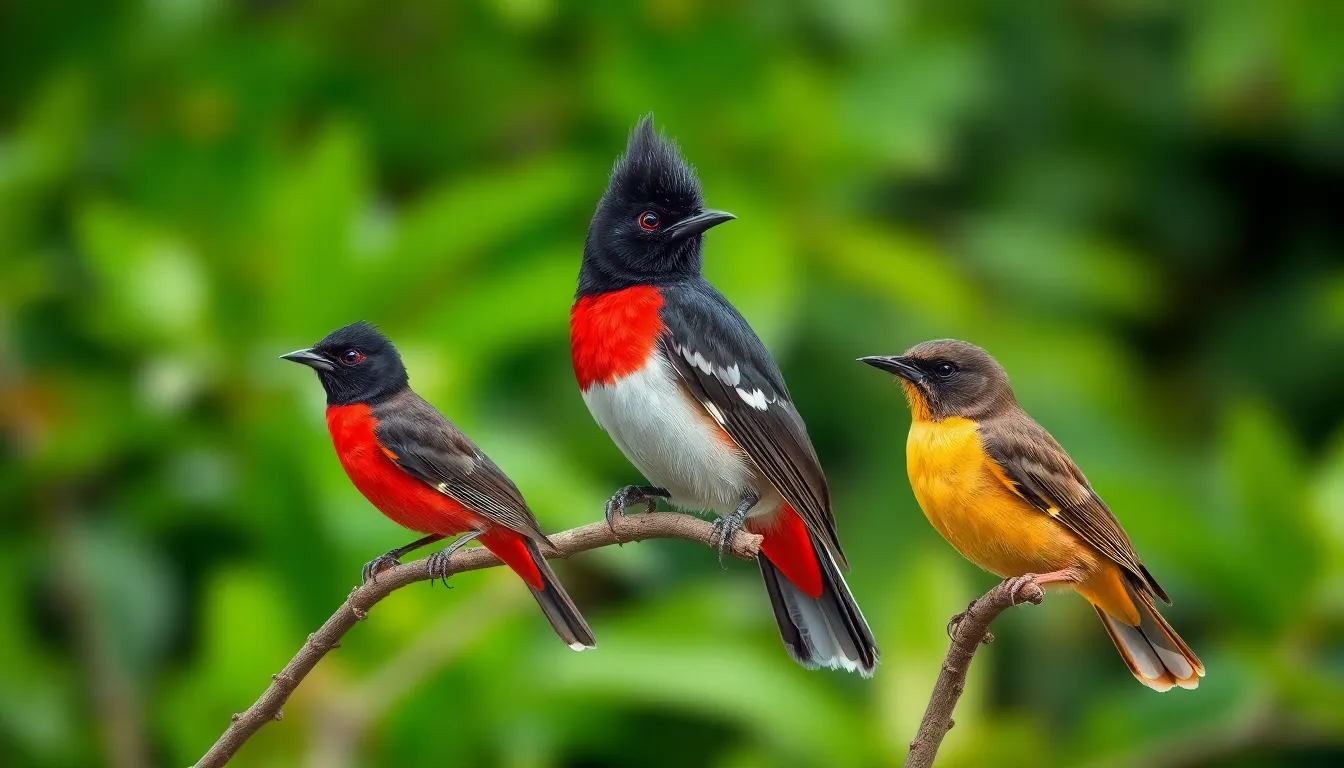
Bulbul birds cover over 150 distinct species worldwide, each displaying unique characteristics and adaptations. These remarkable songbirds showcase incredible diversity in size, coloration, and behavioral patterns across their extensive range.
Red Whiskered Bulbul
Red whiskered bulbuls (Pycnonotus jocosus) stand out with their distinctive crimson ear patches and black crested heads. These 7 to 8 inch birds display white cheeks that contrast sharply with their dark upperparts and brownish wings. Native to tropical Asia, including India, Myanmar, and southern China, red whiskered bulbuls thrive in gardens, parks, and forest edges where they feast on berries, insects, and flower nectar.
Breeding occurs between March and August, with females constructing cup-shaped nests using twigs, roots, and grass. Each clutch contains 2 to 4 pink or white eggs speckled with reddish brown markings. Red whiskered bulbuls demonstrate remarkable adaptability to urban environments, often becoming common residents in cities across Southeast Asia and introduced populations in Australia and Hawaii.
Red Vented Bulbul
Red vented bulbuls (Pycnonotus cafer) feature bright red undertail coverts that give this species its distinctive name. These 8 to 9 inch birds display brown upperparts with darker heads and prominent white rump patches visible during flight. Found throughout the Indian subcontinent, red vented bulbuls inhabit diverse environments from dense forests to bustling city centers.
Social groups of 6 to 10 individuals frequently gather at fruiting trees, creating lively feeding congregations. Red vented bulbuls construct their nests in thorny bushes or small trees, typically 3 to 10 feet above ground. Females lay 2 to 4 glossy eggs that range from pale pink to deep salmon color with purple or brown spots scattered across the surface.
Yellow Vented Bulbul
Yellow vented bulbuls (Pycnonotus goiavier) showcase vibrant yellow undertail coverts paired with olive brown upperparts and grayish white underparts. These medium sized birds measure 7 to 8 inches in length and possess slightly curved bills perfect for extracting nectar from flowers. Southeast Asian forests, mangroves, and cultivated areas provide ideal habitats for yellow vented bulbuls from Thailand to Indonesia.
Omnivorous feeding habits include ripe fruits like figs and berries, flying insects, and sweet nectar from various flowering plants. Yellow vented bulbuls build compact nests using fine twigs and plant fibers, positioning them 6 to 15 feet high in dense foliage. Breeding pairs produce 2 to 3 eggs per clutch, with both parents sharing incubation duties for approximately 12 days before chicks hatch.
Natural Habitat and Distribution

Bulbul species inhabit diverse ecosystems across Africa, Asia, and the Middle East, establishing territories in environments ranging from dense tropical forests to bustling urban centers. Africa hosts approximately 60 bulbul species, with concentrations in sub-Saharan regions where species like the Cape Bulbul and Dark-capped Bulbul thrive in Mediterranean climates and woodland savannas. Asia supports the largest bulbul populations, encompassing over 80 species distributed from the Indian subcontinent through Southeast Asia to southern China and Japan.
Tropical and subtropical forests serve as primary habitats for most bulbul species, providing dense canopy cover and abundant food sources. Secondary growth forests, forest edges, and cultivated areas with scattered trees attract species such as the Red-whiskered Bulbul and Yellow-vented Bulbul. Garden environments, parks, and agricultural landscapes support thriving populations due to diverse plant species that offer fruits, nectar, and insect prey.
Elevation preferences vary significantly among bulbul species, with some inhabiting sea-level coastal areas while others occupy montane regions up to 8,200 feet in the Himalayas. Lowland species like the Red-vented Bulbul dominate plains and river valleys across the Indian subcontinent. Highland specialists including the Black Bulbul prefer cooler mountain forests between 3,300 and 6,600 feet elevation.
Urban adaptation demonstrates remarkable flexibility in habitat selection among certain bulbul species. Cities throughout Asia host established populations of Red-whiskered Bulbuls, Yellow-vented Bulbuls, and Red-vented Bulbuls that exploit ornamental plants, fruit trees, and insect populations. Suburban areas with mixed vegetation provide optimal conditions combining natural food sources with nesting sites in shrubs and small trees.
| Region | Number of Species | Primary Habitats | Notable Examples |
|---|---|---|---|
| Africa | ~60 species | Savannas, woodlands, gardens | Cape Bulbul, Dark-capped Bulbul |
| Asia | ~80 species | Tropical forests, urban areas | Red-whiskered, Yellow-vented |
| Middle East | ~15 species | Scrublands, oases, parks | White-eared Bulbul, White-cheeked Bulbul |
Climate preferences generally favor warm, humid conditions with year-round temperatures above 50°F, though some species tolerate seasonal temperature fluctuations. Monsoon regions provide ideal conditions with abundant rainfall supporting lush vegetation and diverse insect populations. Mediterranean climates in parts of Africa and the Middle East support specialized species adapted to drier conditions with seasonal precipitation patterns.
Diet and Feeding Behavior
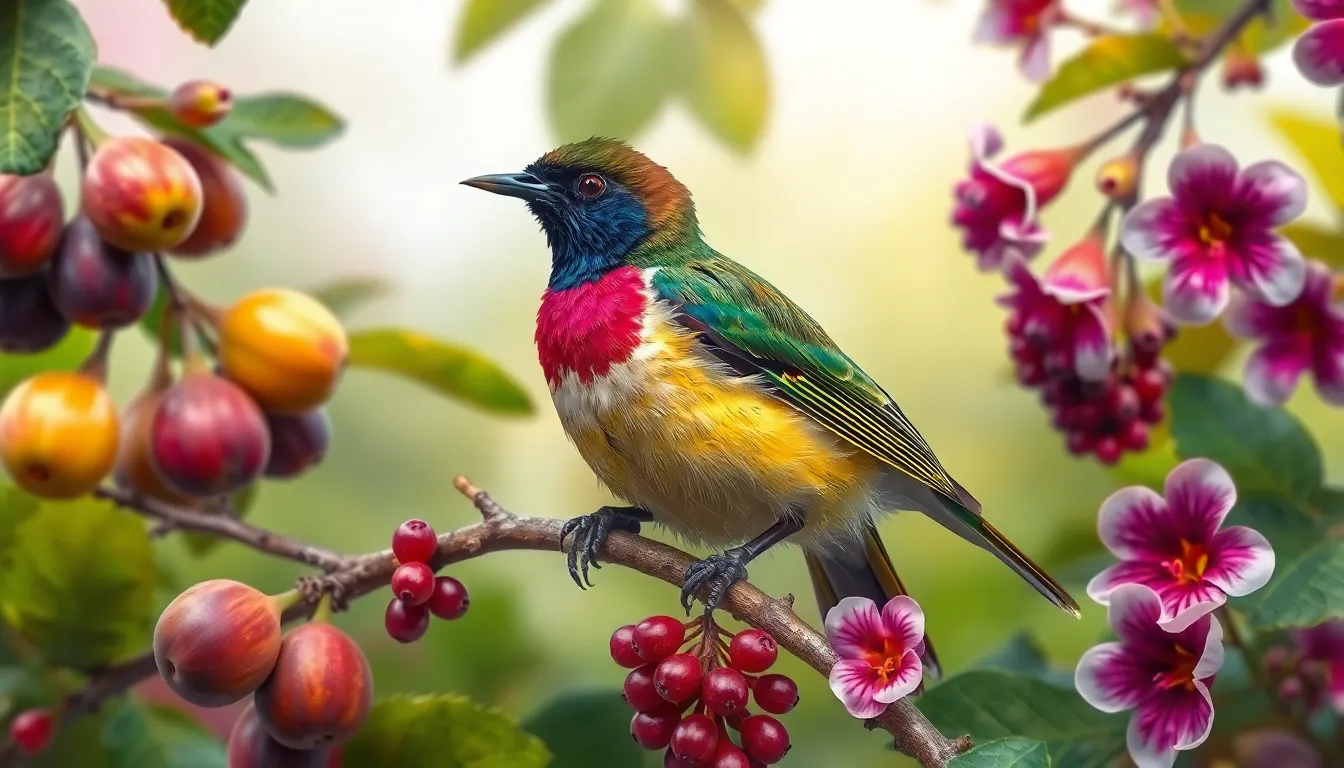
Bulbul birds exhibit omnivorous feeding patterns that include fruits, insects, nectar, and small invertebrates. These adaptable songbirds consume approximately 40-60% fruits and berries, with the remaining portion consisting of protein-rich insects and other food sources. We observe bulbuls foraging actively during early morning and late afternoon hours when food availability reaches peak levels.
Fruits form the cornerstone of most bulbul species’ diets, particularly figs, berries, and small drupes from native trees. Common fruit choices include mulberries, elderberries, and wild cherries that provide essential sugars and vitamins. Bulbuls demonstrate selective feeding behavior by choosing ripe fruits over unripe ones, maximizing nutritional intake while minimizing energy expenditure.
Insects constitute the primary protein source for bulbuls, especially during breeding season when nutritional demands increase significantly. We find these birds consuming beetles, moths, caterpillars, ants, and flies through various hunting techniques. Red-whiskered Bulbuls catch flying insects mid-air, while Yellow-vented Bulbuls prefer gleaning insects from leaves and bark surfaces.
Nectar feeding occurs frequently among bulbul species, particularly those inhabiting tropical regions with abundant flowering plants. Flowers from hibiscus, bottlebrush, and banana plants attract bulbuls seeking high-energy nectar sources. Their pointed bills enable efficient nectar extraction without damaging delicate flower structures.
Feeding techniques vary considerably across different bulbul species and environmental conditions. Ground foraging involves scratching through leaf litter to uncover hidden insects and small invertebrates. Canopy feeding requires acrobatic movements as bulbuls hang upside down to reach fruits on thin branches. We observe bulbuls using their sturdy legs to maintain balance while accessing food sources in challenging positions.
Social feeding behaviors emerge when food sources become abundant, creating temporary feeding aggregations of 10-30 individuals. Red-vented Bulbuls often feed in mixed species flocks alongside other songbirds, sharing information about productive foraging locations. Territorial disputes rarely occur during these communal feeding events if food remains plentiful.
Seasonal dietary shifts reflect changing food availability throughout the year in bulbul habitats. Summer months bring increased insect consumption to support breeding activities and chick rearing. Winter periods see heightened fruit consumption as insects become scarce and energy conservation becomes critical for survival.
Human environments provide supplementary food sources that many bulbul species readily exploit. Garden fruits like papayas, bananas, and cultivated berries attract urban dwelling bulbuls seeking easy meals. We notice these birds adapting their natural foraging schedules to coincide with human gardening activities and fruit ripening cycles.
Breeding and Nesting Patterns
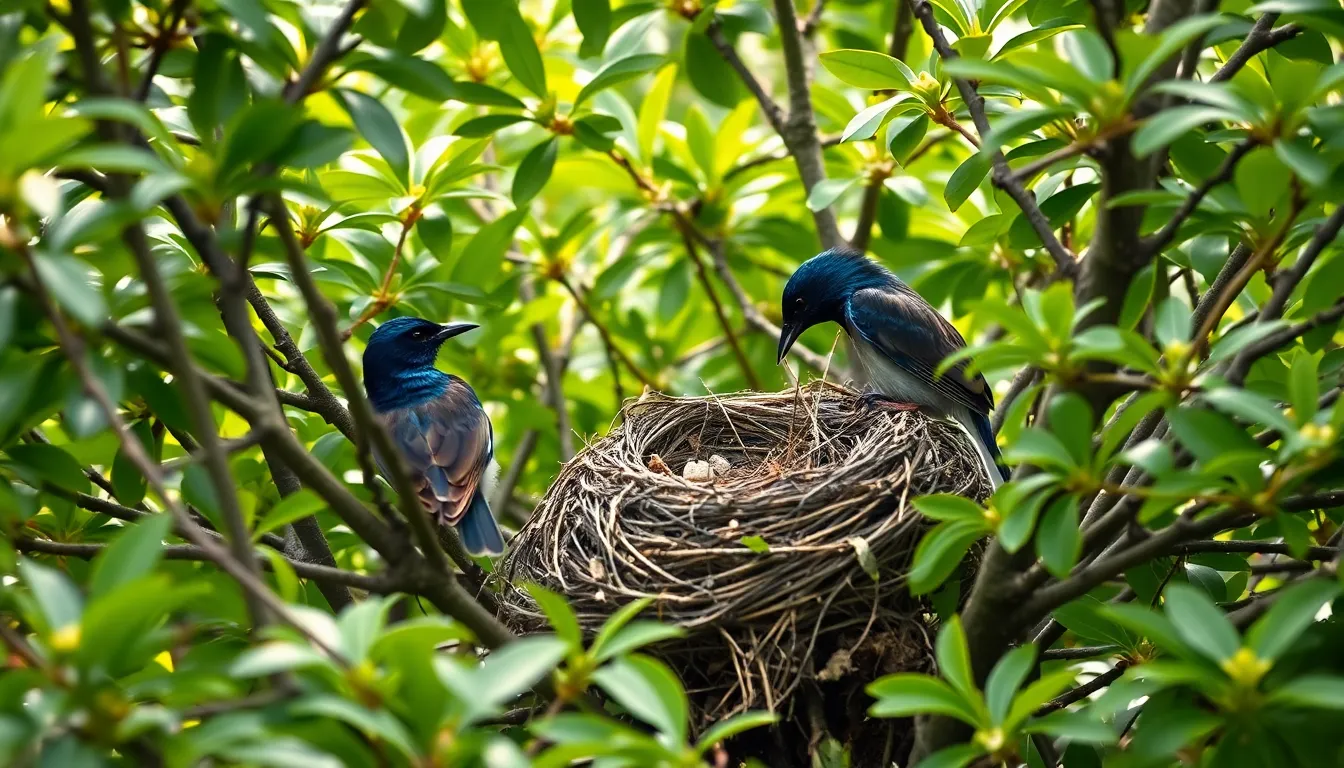
Bulbul birds demonstrate fascinating reproductive strategies that vary significantly across the 150+ species within the Pycnonotidae family. Breeding seasons typically align with favorable food availability and weather conditions, with most species reproducing between March and September in temperate regions.
Nest Construction and Location
Nest building represents a collaborative effort between male and female bulbuls. These songbirds construct cup-shaped nests using twigs, grass, leaves, and moss, often incorporating spider webs and lichens for structural integrity. Preferred nesting sites include dense shrubs, tree branches at heights ranging from 3 to 15 feet, and thick vegetation that provides adequate cover from predators.
Red-whiskered Bulbuls select nesting locations in thorny bushes and bamboo groves, while Yellow-vented Bulbuls favor fruit trees and ornamental plants in urban environments. Construction typically takes 4 to 7 days, with both partners contributing materials and weaving techniques.
Egg Laying and Incubation
| Species | Clutch Size | Incubation Period | Eggs per Season |
|---|---|---|---|
| Red-whiskered Bulbul | 2-4 eggs | 12-14 days | 2-3 clutches |
| Red-vented Bulbul | 2-3 eggs | 13-15 days | 2-4 clutches |
| Yellow-vented Bulbul | 2-4 eggs | 12-13 days | 2-3 clutches |
Female bulbuls lay glossy eggs with pink or pale blue base colors, marked with brown or purple speckles. Incubation responsibilities fall primarily on females, though males provide food and territory defense during this critical 12-15 day period.
Parental Care and Fledgling Development
Both parents participate actively in feeding nestlings once eggs hatch. Chicks remain in the nest for 10 to 16 days, depending on species and environmental conditions. Parents deliver food every 15 to 30 minutes during daylight hours, focusing on protein-rich insects and soft fruits.
Fledglings leave the nest with incompletely developed flight capabilities but continue receiving parental care for an additional 2 to 3 weeks. Family groups often remain together throughout the breeding season, with older offspring sometimes assisting in feeding younger siblings.
Territorial Behavior and Mate Selection
Male bulbuls establish territories averaging 0.5 to 2 acres during breeding season. Territorial displays include melodious singing from prominent perches, wing spreading, and aggressive chasing of intruders. These vocalizations serve multiple functions: attracting potential mates, defining territorial boundaries, and coordinating with established partners.
Pair bonds typically last for one breeding season, though some species maintain monogamous relationships across multiple years. Courtship rituals involve elaborate songs, food sharing, and synchronized movements between potential partners.
Breeding Success Factors
Environmental factors significantly influence bulbul breeding success rates. Adequate food availability increases clutch sizes and reduces nestling mortality. Urban populations often experience modified breeding schedules due to artificial lighting and consistent food sources from human activities.
Predation pressure from snakes, cats, and other birds affects nest placement strategies. Successful pairs often reuse favorable nesting sites in subsequent breeding attempts, with nest site fidelity rates reaching 60-70% among established territories.
Bulbul Bird Behavior and Social Structure
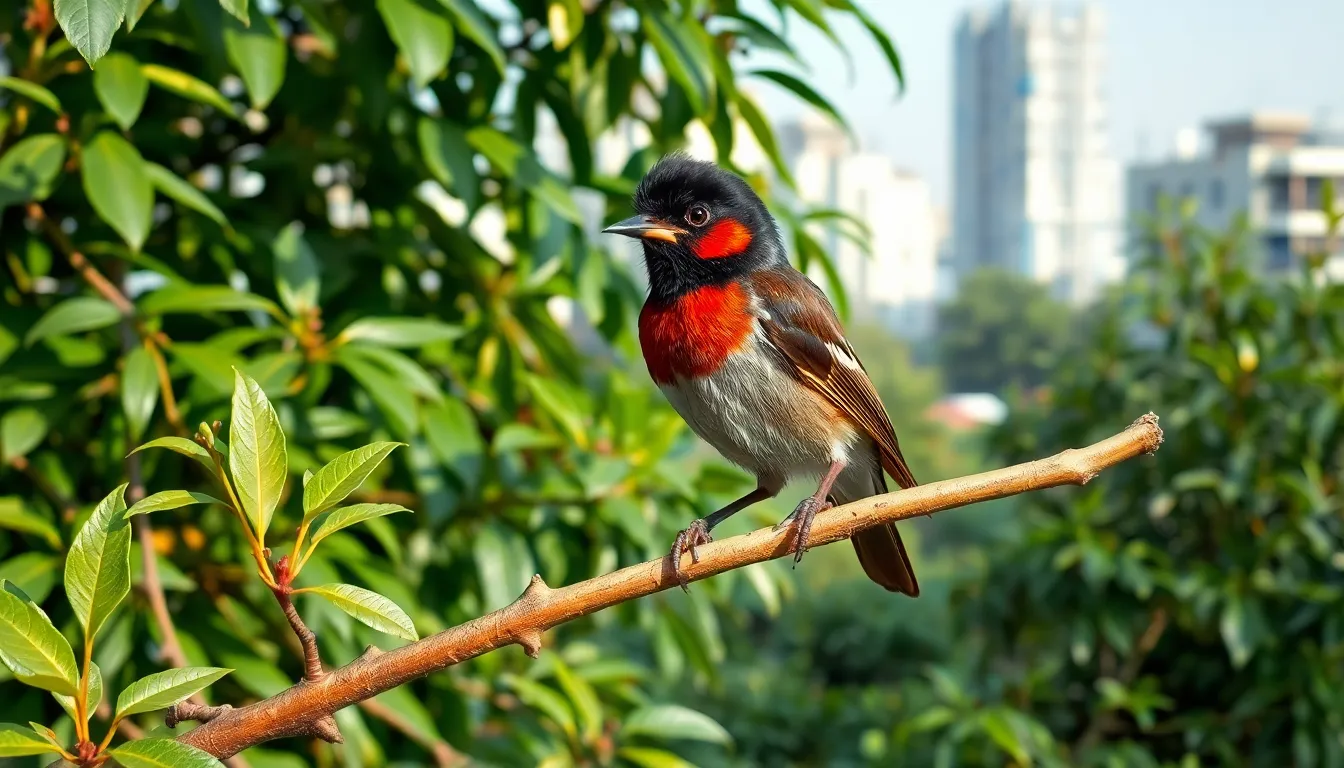
Bulbul birds exhibit complex social behaviors that demonstrate their intelligence and adaptability across diverse environments. These remarkable songbirds maintain intricate social hierarchies while displaying sophisticated communication patterns within their communities.
Territorial Nature
Male bulbuls establish territories ranging from 0.5 to 2 acres during breeding season, defending prime feeding and nesting areas through aggressive displays and vocal warnings. Territory boundaries are maintained year-round by resident species, with males patrolling perimeters at dawn and dusk when activity peaks. Territorial disputes involve chasing intruders, wing flapping displays, and intense vocalizations that can last 5 to 15 minutes.
Red-whiskered Bulbuls defend territories containing 3 to 5 fruiting trees, while Yellow-vented Bulbuls focus on areas with dense shrub cover for nesting protection. Females participate in territorial defense by joining males in boundary patrols and supporting aggressive encounters against neighboring pairs. Territorial size decreases in urban environments where food sources are concentrated, with some pairs defending spaces as small as 0.2 acres in city parks.
Seasonal territorial behavior shifts occur outside breeding periods, with many species forming loose feeding flocks that temporarily abandon territorial restrictions. Non-breeding territories are smaller and less vigorously defended, focusing primarily on roosting sites rather than comprehensive area control.
Vocal Communication
Bulbul vocalizations comprise over 20 distinct call types that serve exact social functions including territory establishment, mate attraction, and predator alerts. Contact calls maintain group cohesion during foraging, with family groups exchanging soft chirps every 30 to 60 seconds to coordinate movement through vegetation. Dawn choruses begin 30 minutes before sunrise, with males producing complex songs lasting 2 to 4 minutes to establish territorial claims.
Alarm calls vary in intensity and frequency based on threat level, with sharp, repetitive notes alerting other bulbuls to aerial predators like hawks and falcons. Ground predator warnings consist of lower-pitched, prolonged calls that prompt immediate cover-seeking behavior from nearby birds. Juvenile bulbuls learn vocal patterns through 6 to 8 weeks of practice, initially producing incomplete versions of adult calls.
Duetting behavior occurs between mated pairs, with synchronized calling patterns that strengthen pair bonds and reinforce territorial boundaries. Contact calls travel effectively through dense vegetation for distances up to 200 meters, enabling separated group members to maintain acoustic contact. Seasonal vocal activity peaks during breeding months, with calling frequency decreasing by 40% during molting periods when energy conservation becomes critical.
Human environments influence bulbul vocal behavior, with urban populations producing louder calls and higher frequencies to overcome ambient noise pollution from traffic and machinery.
Bulbul Birds as Pets
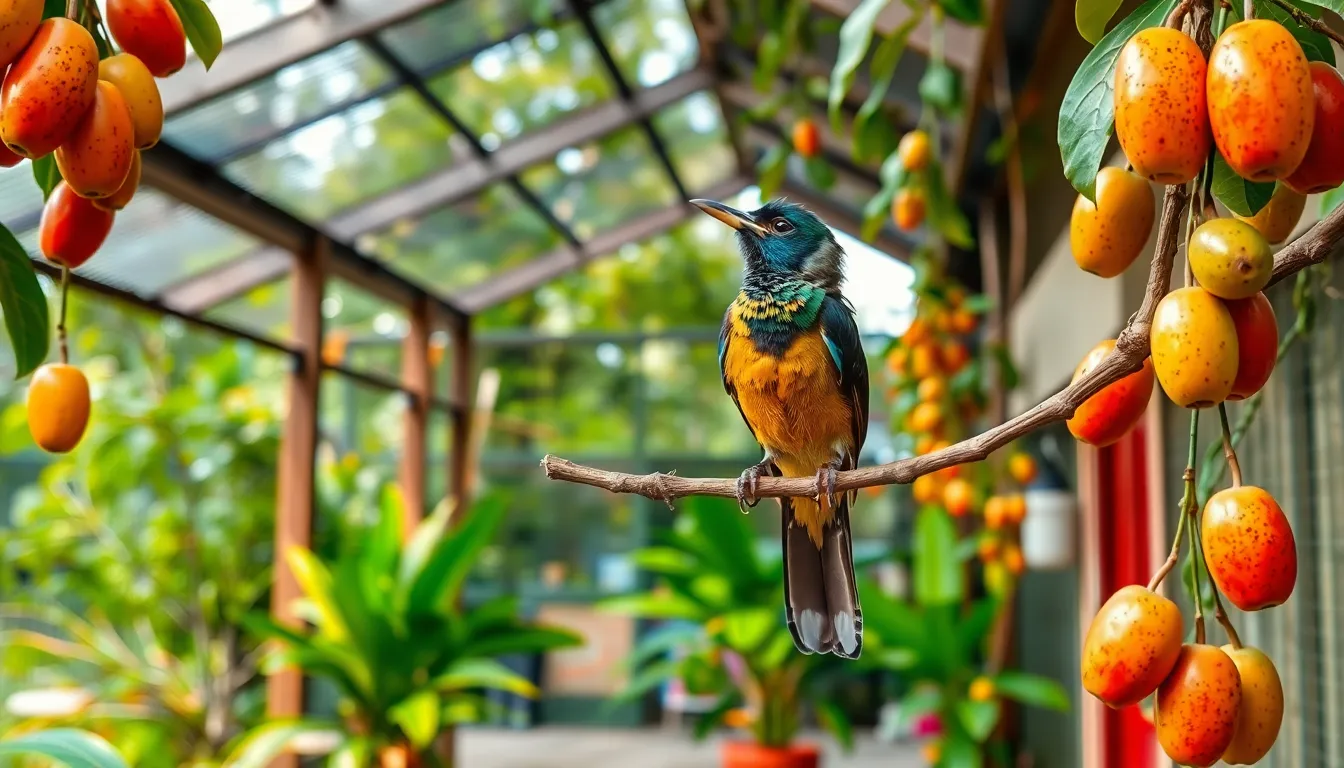
Bulbul birds attract many potential pet owners with their melodious songs and vibrant personalities, though keeping these wild songbirds requires careful consideration of their complex needs. Most species aren’t suited for captivity due to their exact environmental and social requirements.
Care Requirements
Housing bulbuls demands spacious flight cages measuring at least 6 feet long, 4 feet wide, and 6 feet tall to accommodate their active nature. We recommend outdoor aviaries for optimal welfare, as these birds require extensive flight space and environmental enrichment.
Diet complexity presents important challenges for bulbul owners. Fresh fruits comprise 40-60% of their nutritional intake, requiring daily provision of berries, figs, and tropical fruits like papaya and mango. Protein sources include live insects such as crickets, mealworms, and fruit flies, particularly during breeding season when intake increases by 30%. Commercial softbill pellets supplement their diet but cannot replace natural food sources.
Temperature regulation requires maintaining 70-85°F environments with humidity levels between 50-70%. Bulbuls originate from tropical and subtropical regions, making them sensitive to temperature fluctuations below 65°F.
Social interaction becomes critical since bulbuls exhibit complex flock behaviors in the wild. Solitary captivity often leads to stress-related behaviors including feather plucking and decreased vocalization. Multiple bird housing arrangements better replicate their natural social structures.
Veterinary care specialization remains limited, as few practitioners possess extensive bulbul knowledge. Regular health monitoring includes weight checks, feather condition assessment, and behavioral observation for signs of illness or distress.
Legal Considerations
International regulations severely restrict bulbul ownership across most countries. The Convention on International Trade in Endangered Species (CITES) lists several bulbul species under protective appendices, prohibiting commercial trade without proper permits.
United States federal law classifies most bulbul species as protected migratory birds under the Migratory Bird Treaty Act. Possession without federal permits carries penalties up to $15,000 in fines and six months imprisonment. State regulations often impose additional restrictions, with some jurisdictions completely prohibiting bulbul ownership.
Permit acquisition involves extensive documentation including breeding facility registration, veterinary health certificates, and annual reporting requirements. Processing times typically span 6-12 months, with approval rates remaining low for private ownership applications.
Import restrictions prevent legal acquisition of wild-caught bulbuls in most developed countries. Captive-bred birds require detailed lineage documentation and health certifications from approved breeding facilities.
We strongly advise consulting local wildlife authorities and avian veterinarians before considering bulbul ownership. Alternative options include supporting bulbul conservation efforts or creating bird-friendly gardens to attract wild populations for observation and enjoyment.
Conservation Status and Threats
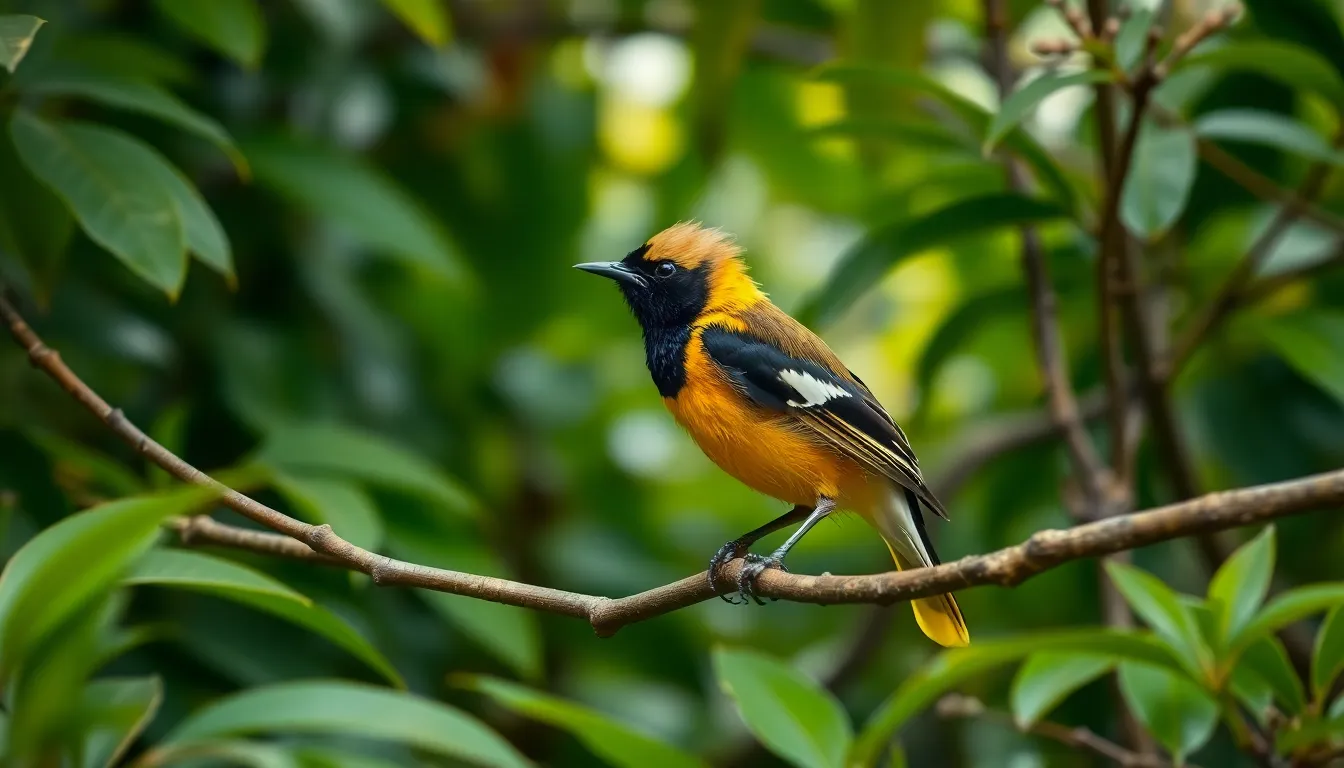
Bulbul populations face varying degrees of conservation challenges across their global range. The International Union for Conservation of Nature (IUCN) lists most bulbul species as “Least Concern,” though several face important threats requiring immediate attention.
Endemic species experience the greatest vulnerability to population decline. The Straw-headed Bulbul (Pycnonotus zeylanicus) carries an “Endangered” status due to extensive trapping for the illegal pet trade in Southeast Asia. The Black-and-white Bulbul (Pycnonotus melanoleucos) faces similar pressures in its limited range across southern Thailand and Malaysia.
Habitat destruction poses the primary threat to bulbul populations worldwide. Deforestation rates in tropical regions eliminate approximately 10 million hectares annually, directly impacting forest-dwelling species like the Hook-billed Bulbul and Ashy Bulbul. Urban development fragments their natural corridors, isolating populations and reducing genetic diversity.
Agricultural expansion creates additional pressures on bulbul communities. Pesticide use eliminates insect populations that form crucial dietary components during breeding seasons. Monoculture plantations replace diverse fruit-bearing trees that support year-round feeding requirements.
Climate change alters migration patterns and breeding cycles for several bulbul species. Rising temperatures shift suitable habitat ranges upward by 150-300 meters per decade in mountainous regions. Changing precipitation patterns affect fruit production timing, creating mismatches between peak food availability and nestling development periods.
| Threat Category | Impact Level | Affected Species Count | Primary Regions |
|---|---|---|---|
| Habitat Loss | High | 45+ species | Southeast Asia, Africa |
| Illegal Trade | Severe | 12 species | Indonesia, Malaysia, Thailand |
| Climate Change | Moderate | 30+ species | Global |
| Pesticide Use | Moderate | 25+ species | Agricultural zones |
Conservation efforts focus on habitat protection and anti-trafficking measures. The Convention on International Trade in Endangered Species (CITES) regulates bulbul trade, with several species listed under Appendix II protections. Protected area networks in biodiversity hotspots safeguard critical bulbul habitats across 15 countries.
Community-based conservation programs engage local populations in protection efforts. Ecotourism initiatives provide economic alternatives to bird trapping in rural communities. Educational campaigns raise awareness about bulbul ecological importance and illegal trade consequences.
Research initiatives monitor population trends through citizen science programs and professional surveys. The eBird database contains over 2.5 million bulbul observations, providing crucial data for conservation planning. Genetic studies help identify isolated populations requiring targeted protection measures.
Conclusion
Bulbuls truly stand out as remarkable avian companions that enrich our natural industry through their melodious voices and vital ecological contributions. These adaptable birds continue to thrive alongside human development while maintaining their essential roles as seed dispersers and pest controllers.
We’ve explored how their complex social structures and diverse species characteristics make them fascinating subjects for observation and study. Their resilience in urban environments demonstrates nature’s incredible ability to adapt and coexist with our expanding cities.
As we move forward it’s crucial that we support conservation efforts to protect vulnerable species like the Straw-headed Bulbul. Whether through habitat preservation community engagement or simply creating bird-friendly spaces in our own gardens we can all contribute to ensuring these melodious birds continue to grace our industry for generations to come.
Frequently Asked Questions
What is a bulbul bird?
A bulbul is a melodious songbird belonging to the Pycnonotidae family. These medium-sized birds, measuring 6 to 11 inches in length, are known for their beautiful songs and vibrant plumage. Over 150 species exist across Africa, Asia, and the Middle East, displaying diverse colors from olive-green and yellow to striking black and white patterns.
Where do bulbuls live naturally?
Bulbuls inhabit diverse ecosystems across Africa, Asia, and the Middle East. They thrive in various environments including forests, gardens, parks, and urban areas. Their remarkable adaptability allows them to flourish in both wild and human-modified landscapes, making them common sights in cities and towns throughout their range.
What do bulbuls eat in the wild?
Bulbuls are omnivorous birds with a varied diet consisting of fruits, insects, nectar, and small invertebrates. Their pointed bills are perfectly adapted for this diverse feeding behavior. They exhibit seasonal dietary shifts and selective feeding habits, often feeding socially in groups while playing crucial ecological roles as seed dispersers and pest controllers.
Can bulbuls be kept as pets?
Keeping bulbuls as pets requires careful consideration due to their complex needs and legal restrictions. Many species are protected under international and federal laws. They require specialized housing, temperature regulation, social interaction, and specific dietary requirements. Potential owners should consult local wildlife authorities and avian veterinarians before considering bulbul ownership.
Are bulbuls endangered?
Most bulbul species are listed as “Least Concern” by the IUCN. However, some species like the Straw-headed Bulbul face endangerment due to illegal trapping for the pet trade. Primary threats include habitat destruction, agricultural expansion, and climate change. Conservation efforts focus on habitat protection and anti-trafficking measures.
How do bulbuls communicate?
Bulbuls are highly vocal birds with complex communication systems. Their songs serve multiple purposes including territory establishment, mate attraction, and danger alerts. They engage in constant vocal communication within family groups and exhibit sophisticated social behaviors, including cooperative breeding and hierarchical social structures.
What role do bulbuls play in their ecosystem?
Bulbuls serve as important seed dispersers and natural pest controllers in their ecosystems. By consuming various fruits, they help spread plant seeds across different areas, promoting forest regeneration. They also control insect populations by feeding on various pests, making them valuable contributors to ecological balance.
How big do bulbuls get?
Most bulbul species measure between 6 to 11 inches in length and weigh between 0.5 to 2.5 ounces. They feature compact bodies with sturdy legs for navigating dense vegetation and moderate-length wings for agile flight. Their size varies among the 150+ species, with some being smaller and others reaching the upper size range.

